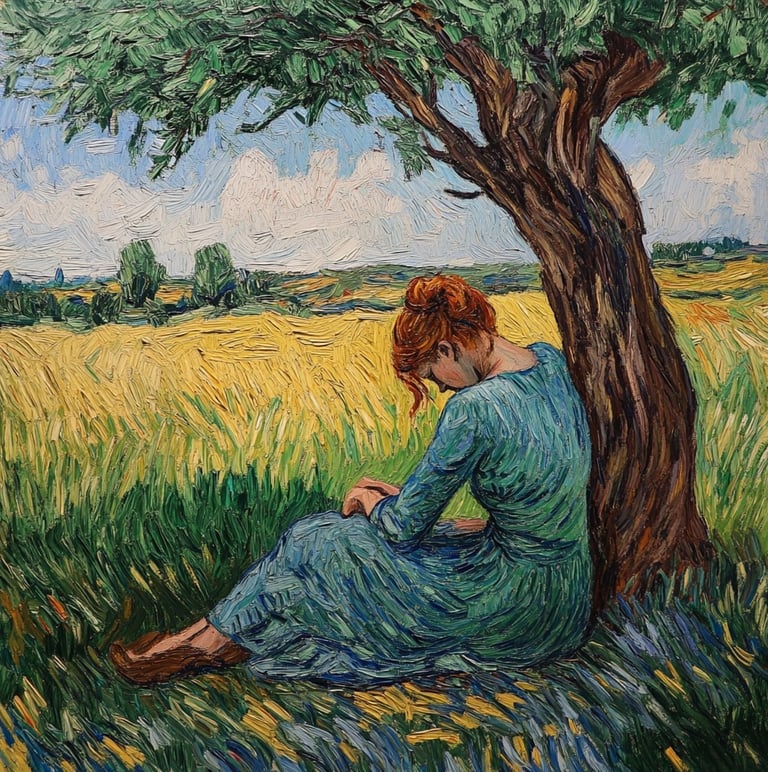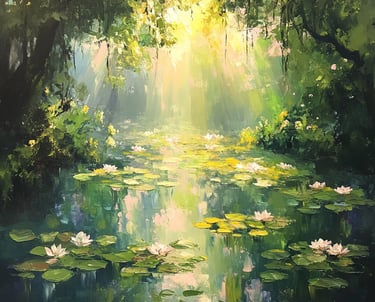A Tale of Two Masters: Comparing Van Gogh and Monet
A gentle comparison of two great artists




AI Generated image in Van Gogh stye
AI Generated image in Monet stye
Comparing Van Gogh and Monet
Vincent van Gogh and Claude Monet are two luminaries in the world of art, each contributing to the evolution of painting in the late 19th century. Born in the Netherlands in 1853, Van Gogh's career was characterized by an emotionally intense exploration of color and form. His tumultuous life, marked by struggles with mental health, greatly influenced his artistic output. Van Gogh’s journey began as a post-impressionist painter, though he is often seen as a precursor to modern art movements. His use of dramatic brush strokes and vivid colors seeks to convey personal emotion rather than attempt a realistic replication of the world around him.
Conversely, Claude Monet, born in France in 1840, became a founding figure in the Impressionist movement. Monet’s approach emphasized capturing light and its transient qualities, often painting en plein air to portray scenes of everyday life with a true depth of color. He preferred his painting techniques that involved quick brush strokes and a focus on the interplay of light and shadow. Monet's series works, including the famous Water Lilies and Haystacks, highlight his dedication to depicting the changing atmosphere of nature. Both artists shared a passion for experimentation, yet their work diverged significantly in style and thematic concerns.
The historical context in which both artists worked is crucial to understanding their significance in art history. The late 19th century was a period of rapid change, with industrialization reshaping society and art’s role within it. While Van Gogh's paintings reflect inner turmoil and maybe a quest for meaning, Monet’s works celebrate beauty and the simplicity of the natural world. Together, these masters represent two different paths within the broader artistic movement of Impressionism, inviting further exploration into their individual philosophies and stylistic choices.
Artistic Styles and Techniques
Vincent Van Gogh and Claude Monet represent two pivotal movements within the realm of Impressionism, yet their artistic styles and techniques are notably distinct, each reflecting their unique perspectives and emotions. Van Gogh is renowned for his robust use of color, which he applied with bold, dynamic brushstrokes that convey a sense of urgency and passion. His iconic work, 'Starry Night,' exemplifies this technique; the swirling skies and luminescent stars are a vivid manifestation of his inner turmoil and deep emotional responses to the world around him. The expressive forms in Van Gogh's paintings often seem to vibrate with energy, inviting the viewer to engage intimately with the complexities of his emotional experiences.
In contrast, Claude Monet focused on the subtle interplay of light and atmosphere, using softer brushwork to capture fleeting moments in time. His series of 'Water Lilies' demonstrates his masterful approach to light as it plays off the surface of the water, creating a serene and contemplative environment. Monet’s technique involves broken color and rapid strokes that blend optically rather than physically, allowing the viewer's eye to complete the image. This method enhances the ephemeral quality of nature, evoking a sense of tranquility and introspection.
Themes and Subject Matter
Vincent van Gogh and Claude Monet, though contemporaries in the world of art, share a distinct dichotomy in their thematic journey and subject matter. Van Gogh's work often features the complexities of human emotion, identity, and the challenges inherent in everyday existence. Notably, his painting 'The Potato Eaters' casts a stark gaze upon the lives of rural peasantry, illustrating their hardships and resilience. His expressive brushwork communicates a raw emotional intensity that invites viewers to contemplate the inherent nature of humanity amidst struggle. Through his artistry, Van Gogh provides a window into the psychological depths of his subjects, emphasizing their individual stories, and people love a good story.
In contrast, Claude Monet embraces a thematic focus on the beauty of nature and the sublime beauty found within it. His landscapes capture ephemeral moments, as evidenced in his iconic work 'Impression, Sunrise.' Monet’s love affair with light and color embodies the fleeting essence of time, inviting the observer into a world where nature is ever-changing and its beauty observable through fleeting impressions. His serene gardens, water scenes, and explorations of atmospheric effects create a sense of tranquility that contrasts sharply with the emotional turmoil depicted in Van Gogh's repertoire.
The settings of both artists further sculpt their artistic perspectives. Van Gogh's post-war rural life, characterized by grim realities, serves as a backdrop for his fascination with the depths of human experience. Conversely, Monet's depictions of serene gardens and tranquil waterways reflect a desire to capture fleeting moments of peace and beauty. These contrasting environments play a pivotal role in shaping their distinct artistic styles, ultimately leading to the profound divergences inherent in their works.
Legacy and Impact on Modern Art
The legacies of Vincent van Gogh and Claude Monet represent pivotal foundations in the realm of modern art. Their contributions shifted the way artists approach themes such as emotion, light, and perception. Van Gogh’s expressive brushwork and use of color not only underscored the significance of personal interpretation but also offered an early glimpse into expressionism. Conversely, Monet’s pioneering techniques in capturing light and atmosphere through Impressionism reshaped the painter's engagement with the natural world, encouraging a new focus on treasured moments captured in time on canvas.
Both Van Gogh and Monet gained immense recognition that solidified their status as iconic figures in popular culture and art history. Their masterpieces now belong to a collective cultural heritage, resonating with the general public and serving as symbols of artistic genius and individual expression. This recognition has ensured their continued relevance, not just in galleries and museums, but also in everyday life. The appreciation for their insights and techniques permeates modern art education, where their works serve as essential references for understanding artistic evolution. Overall, the impact of Van Gogh and Monet on modern art encourages fresh perspectives and a deeper comprehension of their contributions.
This article contains Amazon Affiliate links, Click here for more info.
Let's Stay in Touch!
Sign up to read the latest. It’s FREE!
hello@artbytoniakay.com
©2023 The Guidry Gallery, LLC
All blog posts are the sole property of The Guidry Gallery LLC, DBA ART by Tonia Kay and are held under copyright. ArtNerd is a product of ART by Tonia Kay. Images, artwork, and contents of this website may not be copied, collected, or used for personal or professional gain without written permission from Tonia Kay Guidry.
